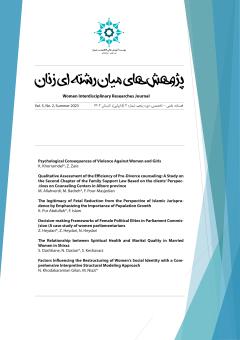Psychological Consequences of Violence Against Women and Girls
Subject Areas :
Zahra Zare
1
![]() ,
Kazem Khorramdel
2
,
Kazem Khorramdel
2
1 - M.A Student in psychology, Department of Psychology, Fatemiyeh Shiraz Institute of Higher Education, Shiraz, Iran.
2 - Ph.D. in psychology, Assistant professor, Department of Psychology, Fatemiyeh Shiraz Institute of Higher Education, Shiraz, Iran.
Keywords: Violence against women, Gender-based violence, Women, Psychological consequences, Mental health.,
Abstract :
Violence against women and girls persists across all human societies despite differences in religions and other intellectual, cultural, economic, and social factors. It is a global, transhistorical and transcultural phenomenon with roots in the history of humanity. This consequence prevents the full participation of women in society and poses a serious threat to human rights and health. Violence has significant effects on women's physical and mental health. Despite extensive research on the consequences of violence on women's mental health, the prevalence of violence has increased during the COVID-19 quarantine period. This study examines the extent of violence against women and girls and its psychological consequences during quarantine. This is a descriptive-analytical cross-sectional study. The instruments used in this study include a Demographic Questionnaire, Standard Violence Against Women Questionnaire and the Hopkins Index (HSCL). Data analysis was conducted by SPSS 26 software. (P <0.01). Pearson correlation analysis revealed a positive and significant relationship between all dimensions of mental health and violence. Exposure to various types of violence leads to a decline in mental health across different dimensions. Violence emerges as a robust predictor of mental health in various dimensions. Considering the important role of women in the family and the impact of their health on family and community well-being, it is imperative to take measures to reduce violence and enhance women's mental health.
1- آقاخانی، نادر؛ افتخاری، علی؛ زارعی خیرآباد، عباس؛ و موسوی، احسان(1391). بررسی انواع خشونت شوهران علیه زنان و تأثیر عوامل مختلف در میزان بروز آنها در زنان مراجعهکننده به پزشکی قانونی شهرستان ارومیه در سال ۹۱-۹۰. پزشکی قانونی ایران، ۱۸(۲ و ۳)، ۷۸-۶۹.
2- بنی¬فاطمه، حسین؛ عباس¬زاده، محمد؛ علیزاده¬اقدم، محمدباقر؛ و محمدپور، نیر(1397). استرس و خشونت فیزیکی مردان علیه زنان: یک تحقیق کیفی. زن در توسعه و سیاست، 16(4)، 581-602.
3- خواجوی سهگنبد، کبری؛ سلیمانیان، علی¬اکبر؛ و حیدرنیا، احمد(1399). عوامل روانشناختی زمینهساز و تداومبخش خشونتپذیری در زنان خشونتدیده؛ مطالعه کیفی. مجله پزشکی قانونی ایران، ۲۶(۳)، 245-۲۳۹.
4- دادور، رحمت¬الهه؛ و ارجمند، بهاره(1392). بررسی پیامدهای روانی اجتماعی مرتبط با خشونت علیه زنان خانه در شهر مشهد در سال 1388-1389. مطالعات علوم اجتماعی ایران، 10(36)، 81-100.
5- دولتیان، ماهرخ؛ حسامی، کژال؛ ظهیرالدین، علیرضا؛ ولایی، ناصر؛ و علوی مجد، حمید(1390). بررسی شیوع خشونت خانگی و نقش آن بر حیطه¬های سلامت روان. پژوهنده، 16(۶)، ۲۸۳-۲۷۷.
6- رزاقی، نغمه؛ پرویزی، سرور؛ رمضانی، منیر؛ و طباطبایی¬نژاد، سید محمد(1392). پیامدهای خشونت علیه زنان در خانواده: یک مطالعه کیفی. مجله زنان، مامایی و نازایی ایران، 16(44)، 11-20. 10.22038/IJOGI.2013.652doi:
7- شایان، آرزو؛ معصومی، سیده زهرا؛ و کاویانی، معصومه(1393). بررسی رابطه همسرآزاری و سلامت روانی در زنان دچار خشونت خانگی ارجاع شده به پزشکی قانونی شهر شیراز. آموزش و سلامت جامعه، ۱(۴)، ۵۷-۵۱.
8- طاهرخانی، سکینه؛ میرمحمدعلی، یی ماندانا؛ کاظم¬نژاد، انوشیروان؛ اربابی، محمد؛ و عامل ولی¬زاده، مهرنوش(1388). بررسی میزان خشونت خانگی علیه زنان و ارتباط آن با مشخصات زوجین. مجله علمی پزشکی قانونی، 15(2)، 123-129.
9- علیوردی¬نیا، اکبر؛ رضی، داوود؛ و آیینی، صدیقه(1392). تبیین جامعهشناختی خشونت علیه زنان: آزمون تجربی نظریههای منابع در دسترس زنان و فمینیسم رادیکال. رفاه اجتماعی، 13(49)، 323-358.
10- محمدخانی، میترا؛ و عباسی دولت¬آبادی، زهرا(1398). پیامدهای روانی خشونت عاطفی بر زنان. هشتمین کنفرانس بینالمللی سلامت زنان، تهران.
11- محمدزاده اسماعیلی، رعنا؛ قنبری¬پناه، افسانه؛ و تجلی، پریسا(1398). رابطه تنظیم هیجانی و عواطف مثبت و منفی مردان متأهل، با نگرش نسبت به خشونت علیه زنان (موردمطالعه: شهر تهران. دوفصلنامه علمی مطالعات پلیس زن، 13(30)، 5-13.
12- موسوی، اشرف¬السادات؛ و قربانی، نیما(1386). روایی تفکیکی فهرست فارسی نشانه مرضی هاپکینز در نمونههای بالینی و بهنجار. روانشناسی تحولی (روانشناسان ایرانی)، 4(13)، 69-79.
13- هزارجریبی، جعفر؛ و میرزایی، رحمت(1396). خشونت و جنسیت (تجربه زیسته زنان و مردان شهرستان پاوه). توسعه اجتماعی، 12(2)، 83-108. doi:10.22055/QJSD.2018.13509
14- World Health Organization. (2020). Department of Sexual and Reproductive Health and Research World Health Organization Avenue Appia 20CH-1211, Geneva 27Switzerlandem. Retrieved from https://www.who.int/teams/health-workforce/hwfequity/sexual-and-reproductive-health-and-research
15- Ibala, R. M., Seff, I., & Stark, L. (2021). Attitudinal acceptance of intimate partner violence and mental health outcomes for female survivors in Sub-Saharan Africa. International journal of environmental research and public health, 18(10), 5099. doi:10.3390/ijerph18105099
16- Krahé, B. (2016). Violence against women. Aggression and Violence, 251-268.
17- Lr, D. (1974). The Hopkins Symptom Checklist (HSCL): a self-report symptom inventory. Behav Sci, 19, 1-15.
18- Saadati, M. (2010). Domestic violence, mental health threat. Social Security Studies, 8(24), 61-90.
19- Sediri, S., Zgueb, Y., Ouanes, S., Ouali, U., Bourgou, S., Jomli, R., & Nacef, F. (2020). Women’s mental health: acute impact of COVID-19 pandemic on domestic violence. Archives of women's mental health, 23, 749-756. doi:10.1007/s00737-020-01082-4


